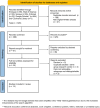Magnetic Sphincter Augmentation for Gastroesophageal Reflux After Sleeve Gastrectomy: A Systematic Review
- PMID: 39402392
- PMCID: PMC11541252
- DOI: 10.1007/s11695-024-07523-8
Magnetic Sphincter Augmentation for Gastroesophageal Reflux After Sleeve Gastrectomy: A Systematic Review
Abstract
This systematic review aims to evaluate the current evidence regarding safety and efficacy of magnetic sphincter augmentation (MSA) for the treatment of gastroesophageal reflux disease (GERD) after laparoscopic sleeve gastrectomy (LSG). Conversion to Roux-en-Y gastric bypass (RYGB) carries the risk of surgical and metabolic complications and may be contraindicated in patients with normalized or near-normalized body mass index. The LINX™ procedure aims to restore LES competency and to repair the crura. We included 109 patients (14 studies) undergoing LINX™ implant after LSG. Median follow-up was 18.9 months (range 0.3-63). Both the GERD-HRQL (38 ± 13 vs. 10 ± 11; p = 0.0078) and daily PPI use (97.4% vs. 25.3%; p < 0.0001) were significantly improved. Overall, 31.8% of the patients experienced device-related adverse events, mainly self-limiting. LINX™ explant for esophageal erosion occurred in 0.9% of the patients.
Keywords: Bariatric surgery; Gastroesophageal reflux; LINX procedure; Magnetic sphincter augmentation; Refractory GERD; Roux-en-Y gastric bypass; Sleeve gastrectomy.
© 2024. The Author(s).
Conflict of interest statement
The authors declare no competing interests.
Figures
Similar articles
-
Magnetic sphincter augmentation: a viable rescue therapy for symptomatic reflux following bariatric surgery.Surg Endosc. 2020 Jul;34(7):3211-3215. doi: 10.1007/s00464-019-07096-z. Epub 2019 Sep 4. Surg Endosc. 2020. PMID: 31485930
-
Long-term outcomes of magnetic sphincter augmentation in sleeve gastrectomy and Roux-en-Y gastric bypass patients: a comprehensive analysis.Surg Endosc. 2024 Sep;38(9):5343-5349. doi: 10.1007/s00464-024-11059-4. Epub 2024 Jul 19. Surg Endosc. 2024. PMID: 39030413 Free PMC article.
-
Feasibility and Efficacy of Magnetic Sphincter Augmentation for the Management of Gastroesophageal Reflux Disease Post-Sleeve Gastrectomy for Obesity.Obes Surg. 2023 Jan;33(1):387-396. doi: 10.1007/s11695-022-06381-6. Epub 2022 Dec 6. Obes Surg. 2023. PMID: 36471179 Free PMC article.
-
Surgical treatment strategies for gastroesophageal reflux after laparoscopic sleeve gastrectomy.Front Endocrinol (Lausanne). 2024 Oct 29;15:1463567. doi: 10.3389/fendo.2024.1463567. eCollection 2024. Front Endocrinol (Lausanne). 2024. PMID: 39534257 Free PMC article. Review.
-
Gastroesophageal reflux disease complicating laparoscopic sleeve gastrectomy: current knowledge and surgical therapies.Surg Obes Relat Dis. 2020 Aug;16(8):1145-1155. doi: 10.1016/j.soard.2020.04.025. Epub 2020 May 4. Surg Obes Relat Dis. 2020. PMID: 32576511
Cited by
-
Understanding Current Challenges of Magnetic Sphincter Augmentation for GERD After Sleeve Gastrectomy.Obes Surg. 2025 Feb;35(2):663-665. doi: 10.1007/s11695-024-07656-w. Epub 2025 Jan 8. Obes Surg. 2025. PMID: 39775394 No abstract available.
-
Critical Insights on Magnetic Sphincter Augmentation for GERD During Sleeve Gastrectomy: Analyzing Limitations and Future Directions.Obes Surg. 2025 Jan;35(1):359-360. doi: 10.1007/s11695-024-07608-4. Epub 2024 Dec 1. Obes Surg. 2025. PMID: 39617810 No abstract available.
-
Individualizing the choice of surgical therapy for gastroesophageal reflux disease.Curr Opin Gastroenterol. 2025 Jul 1;41(4):245-250. doi: 10.1097/MOG.0000000000001082. Epub 2025 Feb 17. Curr Opin Gastroenterol. 2025. PMID: 39964431 Free PMC article. Review.
References
-
- Yeung KTD, Penney N, Ashrafian L, Darzi A, Ashrafian H. Does sleeve gastrectomy expose the distal esophagus to severe reflux?: A systematic review and meta-analysis. Ann Surg. 2020;271(2):257–65. 10.1097/SLA.0000000000003275. - PubMed
-
- Choi SJ, Kim SM. Intrathoracic migration of gastric sleeve affects weight loss as well as GERD–an analysis of remnant gastric morphology for 100 patients at one year after laparoscopic sleeve gastrectomy. Obes Surg. 2021;31(7):2878–86. 10.1007/s11695-021-05354-5. - PubMed
-
- Saber AA, Shoar S, Khoursheed M. Intra-thoracic sleeve migration (ITSM): an underreported phenomenon after laparoscopic sleeve gastrectomy. Obes Surg. 2017;27(8):1917–23. 10.1007/s11695-017-2589-6. - PubMed
Publication types
MeSH terms
LinkOut - more resources
Full Text Sources
Medical
Research Materials



